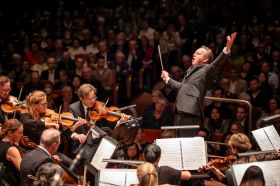Based in NSW’s Illawarra region, Austinmer Dance Theatre is led by teacher and choreographer Michelle Forte, who made a welcoming introductory speech at this short season at Coniston’s Phoenix Theatre prior to the performance proper. uNCOILEd, which Forte hopes will become an annual event, is part of the company’s 2012 season, which was dedicated to the memory of their colleague Nicole Louise Fitzsimons who passed away tragically earlier this year .
Metamorphosis, choreographed by Molly Erin Fitzpatrick, was an intriguing, exciting pas de deux featuring considerable unison work. This strong work also featured use of a high demi-pointe, arabesques, great jumps, and a particular way of using the back, quite sculptural and frieze-like in parts. The dancers were clad in beautiful blue dresses.
While We Wait was a sharp, tense and dramatic quartet set to an ominous, eerie soundtrack. Forte’s choreography demanded a very articulate back, a sizzling line and sharp flicks of movement.
Claustrophobia, choreographed by Melissa Jane Pinn, was strong and powerful. The cast danced clad in wonderfully textured and layered black costumes, in a work which featured assorted repeated phrases of movement, sometimes individual, sometimes followed by the group, with the use often of a deep Graham plie and an angular feel to the choreography. Some of the choreography was machine-like and at one point reminiscent of a snippet of Macmillan’s The Rite of Spring; the way a member of the group was isolated and chosen for death reinforced this impression.
For me the least successful work was the most hyped – the specially commissioned Sanbiki No Kashkoi Saru, choreographed by Maurice Causey. The bird/floral dresses were pretty, but it didn’t really go anywhere or do anything choreographically memorable. The work as a whole was overwhelmed by the strange beeping, breathing, gurgling voice soundtrack.
There is a Time, another piece choreographed by Forte, brought the evening to a close. Also featuring a maddening, pulsating soundtrack, this work boasted terrific short, liquid solos, some intriguing partnering and duets, and disjointed, repeated phrases of movement. It was quite intense and demanded sharp jumps and explosive runs as well as strong unison work .
Also included in the program were four short ‘interludes’ – improvised solos with the dancers in white shirt and black bra and pants. These were most impressive, combining a range of moods (joyous to melancholy) and a varied range of music and dance styles.
Overall, uNCOILEd featured excellent performances in a great program of new work. This is a company and dancers to watch.
Rating: 3 ½ stars out of 5
uNCOILEd
Austinmer Dance Theatre
Choreographers: Molly Erin Fitzpatrick, Michelle Forte, Melissa Jane Pinn and Maurice Causey
Dancers: Molly Fitzpatrick, Melissa Jane Pinn, Olivia Hutchinson Smith, Jodie Toogood, Sophie Wighton, Rhiannon Davies
Phoenix Theatre, Coniston
15 – 16 December






